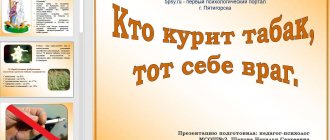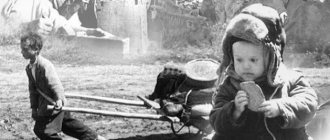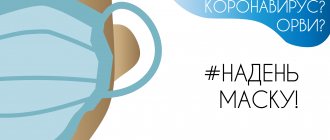Class hour: “Prevention of colds.”
Assignment for classes: (Write words related to influenza on pieces of paper - associations with the word FLU)
Teacher's word (cognitive information): What is the flu:
acute infectious disease of the respiratory tract caused by the influenza virus; included in the group of acute respiratory viral infections (ARVI);
known since the end of the 16th century;
Currently, more than 2,000 variants of the influenza virus have been identified.
Influenza is a disease that literally “is in the air” - it is transmitted by airborne droplets, by inhaling viral particles, and also through objects used by a sick person.
The influenza virus affects at least 15% of the world's population every year.
4. How dangerous is the flu for a schoolchild?
The main danger of the flu is that it can lead to serious complications:
1.Respiratory diseases. 2. Diseases of blood vessels and heart. 3. Diseases of the central nervous system.
You can become infected:
Being near a sick person, especially if they are coughing and sneezing.
Exchanging notebooks and writing materials with sick students, sitting with them at the same desk without a protective bandage, or using the same utensils.
Not observing personal hygiene rules, such as washing hands before eating, keeping clothes clean, etc.
How to understand that you are sick?
At the very beginning of the disease, you may feel chills, weakness and lethargy, and a severe headache. You have a high temperature. On the 2-3rd day of illness, a sore throat, runny nose, and dry cough begins. Some children have a stomach ache and feel sick when they have the flu.
5. Ten steps against the flu:
Step 1:
Wash your hands thoroughly before eating.
There are a large number of germs and bacteria on your hands. If you don't wash your hands, germs will enter your body along with food and cause various diseases. Step 2:
Toughen up.
Hardening is a special training that helps you stay healthy. In order not to be afraid of the cold, you need to be in the fresh air more often, douse yourself with cool water, and swim. Hardening should only be done with parents. Step 3:
Do exercises every morning.
In order for the body to be flexible, healthy, strong and beautiful, you need to do exercises regularly; it will also help protect the body from diseases. Step 4:
Eat a lot of vegetables and fruits.
They also help protect against diseases, and also strengthen the body because they contain vitamins and nutrients. Step 5:
Ventilate your room.
Dust, various germs and bacteria settle on things and objects in your room. In order to prevent all this from entering your body, it is very important to ventilate the room where you sleep, play, and study. Step 6:
Take care of your health.
If someone near you is sick, put on a special mask, it will protect you from the disease. Step 7:
Make friends with the funny tube “Oxaline Ointment”.
Together you can beat colds and flu. Step 8:
Don’t get too cold, dress for the weather.
Step 9:
During a flu epidemic, postpone visiting places with large crowds of people.
Step 10:
In the event of a threat of epidemics, follow the advice of doctors and do not be afraid to get vaccinated.
Prevention of colds
It is generally accepted that colds are unpleasant, but “harmless” attributes of cold weather, and malaise caused by viruses, occurring 1-2 times a year, is the norm. However, every malfunction in the body’s functioning leaves its own negative mark, therefore, in the case of seasonal diseases, one should adhere to the golden rule: A DISEASE IS EASIER TO PREVENT THAN TO TREAT.
Interesting Facts
- 80% of infectious diseases (and flu and colds belong specifically to this group) are transmitted through hands.
- Scientists found the maximum accumulation of viruses on banknotes, computer mice and keyboards, transport handrails and mobile phones.
- Antibiotics do not act on viruses, so taking them as treatment or prevention is useless.
Class hour “Prevention of influenza and colds”
Class hour«Prevention of flu and colds»primary school teacherMBOU gymnasium No. 23:E.V.GAYVANENKOTarget:introduce children to ways to prevent influenza and colds; cultivate a caring attitude towards your own health.
Teacher:
The topic of our class hour is “Prevention of influenza and colds.” How many of you know what “flu” is? (Children's answers)
Slide number 1.Flu
(from French grippe) is an acute infectious disease of the respiratory tract caused by the influenza virus. Currently, more than 2,000 variants of the influenza virus have been identified. Influenza is an extremely contagious infectious disease, dangerous for its complications: damage to the cardiovascular system, central nervous system and respiratory organs.
There's a knock on the door. Flu appears. Flu:
And here you are!!!
Teacher
: Who are you?
Flu:
I? Flu!!! I came specifically to you to make friends with you. This is so good when you have the flu: stay at home, have delicious food prepared for you, don’t study, watch TV...
Teacher:
What are you saying, Gripp, there’s nothing good about being friends with you. Children in our class also had the flu. Please tell us how you felt when you were sick? (Children's answers)
Slide number 2. “Flu symptoms”
- Heat;
- Chills and weakness;
- Pain and aches throughout the body;
- Cough;
- Headache;
- Runny or stuffy nose.
Teacher:
The flu is characterized by a sharp onset: the body temperature rises to 39*C and above, weakness occurs, the person gets chills, suffers from headaches and muscle pain.
For influenza, unlike other viral infections, symptoms such as cough and runny nose do not appear immediately, but several days after the onset of the disease. Slide No. 3. “Ways of transmission of infection”
Influenza is transmitted through the air. The source of infection is a sick person. We become infected by inhaling air containing tiny droplets of saliva and phlegm released by patients when they cough and sneeze. This method of transmission is called airborne transmission.
And also when in contact with patients by shaking hands, exchanging personal hygiene items (handkerchief, towel) and other household items (dishes, telephone, pencils, toys, etc.). This path is called the contact-domestic path. Teacher:
Guys, look, we have balloons hanging in our classroom.
Think of it like flu bacteria. Flu bacteria droplets also look like balls, but they are so small that they can only be seen under a microscope. They fly through the air where there are sick people and can get into the nose and mouth of healthy people. We need to defeat influenza bacteria, and they will disappear if you tell us what to do to avoid getting the flu. (Children's answers. After each child's answer, the teacher pierces one influenza bacteria ball.) Flu:
Look what you are!
I'm not afraid of you! I'm stronger than you! Teacher:
Oh, right!
I’ll now call for the help of the flu vaccine, and then we’ll see who’s stronger! Vaccination appears. Vaccination:
Hello guys!
I am a Vaccination, created specifically to destroy the flu. (Flu gets scared)
I'm friends with all the children.
I'll tell you what you need to do to avoid getting the flu. Slides No. 4-10. "Prevention"
- Today it has already been proven that the main method of specific prevention of influenza is a vaccine or, as we call it, vaccination, which stimulates the body to produce protective antibodies that prevent the multiplication of viruses. Thanks to this, the disease is prevented even before it begins. It is better to get vaccinated in the fall (September-November), since influenza diseases usually begin to be registered between November and March.
After vaccination, immunity develops within two weeks, so vaccination begins in advance. You must be healthy at the time of vaccination. After the preventive vaccination, for several days you should protect yourself from both hypothermia and overheating and limit visits to public places.
- Everyone should prepare their body not only for a “meeting” with the influenza virus, but also other viruses that cause colds. During the period from December to March, it is necessary to pay attention to nonspecific prevention. To reduce diseases, compliance with sanitary and hygienic standards is very important:
— comfortable temperature conditions of the premises;
- regular ventilation;
— daily wet cleaning of premises using detergents;
— hypothermia reduces immunity, so you need to dress according to the weather.
*Personal prevention measures are of no small importance:
- cover your mouth and nose when sneezing and coughing with a handkerchief (napkin), it is advisable to use disposable ones, which must be thrown into the trash after use;
- avoid touching your mouth, nose, eyes;
— keep a distance when communicating, the distance between people when talking should be at least 1 meter (arm's length distance).
* Compliance with the rules of personal hygiene, namely hand washing, is very important for prevention. Wash your hands thoroughly and often with soap or disinfectant. It would seem that such an everyday activity as washing your hands is extremely simple, but there are some rules. How to wash your hands correctly?
- It is necessary to wet your hands under running water;
- Lather soap on your palms and lather well;
- You need to treat your hands with soap foam for at least 10 seconds, because... the effectiveness of detergents depends on their exposure time;
- You need to thoroughly rub all your fingers, palms and the surface of your hands, clean your nails (at this moment you do not need to hold your hands under running water);
- Rinse the soap off your hands under running water for at least 10 seconds;
- When washing your hands, avoid splashing water;
- Hands need to be dried - disposable paper towels are best for this;
- The tap must be closed with a paper towel, because... it is always touched with dirty hands before washing, therefore, there may be germs on the tap;
- Used paper towels should be thrown into the trash bin; do not touch the bin with your hands.
- During epidemics of influenza and colds, it is necessary to:
- avoid close contact with sick people;
— limit attendance at cultural events, reduce time spent in crowded places.
* Prevention of influenza consists of general improvement and strengthening of the body's defenses; for this it is necessary to lead a healthy lifestyle:
— sufficient sleep, it is useful to sleep with the window open, but avoid drafts;
- proper nutrition - daily use of fresh vegetables and fruits in the diet will increase overall immunity to viral diseases. In addition, it is necessary to take ascorbic acid (vitamin C), which helps increase the body's resistance. It should be noted that the largest amount of vitamin C is found in sauerkraut juice, as well as in citrus fruits: lemons, kiwi, tangerines, oranges, grapefruits. For prevention during flu and cold epidemics, it is necessary to consume garlic and onions daily. It is enough to chew a clove of garlic for a few minutes to completely cleanse the oral cavity of bacteria;
- walk more in the fresh air, play sports.
At the first signs of a cold, it is necessary to carry out emergency prevention with interferon, influenza, rimantadine, arbidol.
- Proper use of a medical mask will help protect yourself from contracting viral infections. A disposable mask can be purchased at pharmacies; a cotton-gauze mask can be easily made with your own hands. Unlike a disposable mask, which can be worn for no more than 2 hours, a cotton-gauze bandage can be worn for up to 4 hours, washed and reused. It is important that a sick person wears a mask, as well as a healthy person when communicating with (caring for) a sick person.
Vaccination:
How great!
Now it's time to do some exercises. (Musical physical exercise).
Well done, but this is not enough.
Vitamin C will also help us in the fight against the disease. And here it is. Vitamin C:
Hello guys! I am vitamin C. I am found in fruits and vegetables. Here is a magical tree that bears fruits containing
vitamin C. Guess the riddles and find out what grows on this tree.
Children know this fruit, monkeys love to eat it. It comes from hot countries. It grows in the tropics... (Banana) A sundress is not a sundress, A dress is not a dress, And when you start undressing, You will cry your fill. (Bow) The head looks like a bow. If you just chew even a small slice, it will smell for a very long time. (Garlic) With orange skin, similar to a ball, but in the center it is not empty, but juicy and tasty. (Orange) It’s not very easy to guess - This is the kind of fruit I know - It’s not about a coconut, It’s not about a pear, it’s not about a plum, - There is also such a bird, They call it the same - ... (Kiwi) Far in the south somewhere It grows winter and summer. One will surprise us with himself ... (Pineapple) I was born to glory, My head is white, curly. Who loves cabbage soup - look for Me in them. (Cabbage) Two sisters are green in the summer, By autumn one turns red, the other turns black . (Red and black currants) Same with a fist, Red, yellow barrel. If you touch it with your finger, it’s smooth, And if you bite it, it’s sweet. (Apple) It is almost like an orange, With thick skin, juicy, There is only one drawback - It is very, very sour. (Lemon) Vitamin C:
Thank you, friends!
I was glad to meet you. Now I know you won't get the flu. I want to treat you to ascorbic acid, which contains vitamin C. I have to go, I’ll run to another class and help the kids fight the flu there. Goodbye! Flu:
AAAA gone!
Now I'm in charge here! Now when I sneeze, you’ll know how I’ll infect you all! Vaccination:
Flu, wait!
Have you forgotten that I'm here? (Takes out a syringe and gives an injection) The flu falls and runs away. Vaccination:
Guys, I was glad that I was with you at the right time and in the right place.
I was glad to help you. Now I ran to the hospital, in case someone else needs my help. Goodbye! Slides No. 11. “I got sick. What to do?" —
Minimize contact with other people, do not attend mass events, strive to use public transport as little as possible, avoid close contact with healthy people;
-
observe bed rest - popular wisdom says: “the flu likes to be kept in bed” and medicine agrees with this.
To avoid complications, you need to not only stay at home during all days of illness, but also be sure to stay in bed. Slides No. 12. “If there is a sick person in the house” -
place the sick person in a separate room or fence him off with a screen;
-
allocate separate care items, dishes, bed linen for the patient;
-
the room where the patient is located should be ventilated several times a day and be warm (20-21*C), and daily wet cleaning should be carried out using disinfectants;
-
When caring for a patient, use a mask and wash your hands thoroughly.
Teacher:
Our children know useful tips to avoid getting the flu.
Listen here! In order to maintain health, to strengthen your body, my whole family knows there must be a daily routine. Guys, you should know, Everyone needs to sleep longer, Well, don’t be lazy in the morning, Get ready to exercise. Brush your teeth. Wash yourself, And smile more often, Temper yourself and then, You won’t be afraid of the blues. Health has enemies: Don’t make friends with them! Among them is quiet laziness, you fight it every day! So that not a single microbe accidentally gets into your mouth. Wash your hands before eating with soap and water! Eat vegetables and fruits, fish, dairy products - This is healthy food, full of vitamins! Go for a walk and breathe in the fresh air. Just remember when leaving: Dress for the weather! Well, if it happened: You got sick . Know that it’s time for you to see a doctor, He will always help us. These are the good advice, Secrets are hidden in them. How to maintain health, Learn to appreciate it!!! Teacher:
Thank you very much! I hope that you will follow preventive measures and not get sick. You are already adults and can help your parents take care of the well-being and health of your family! Try together to keep out an uninvited guest with a foreign name: FLU! I wish you and your parents good health!
Catalog:
docs docs -> Curriculum for the special course “Features of physical education in diseases and injuries in children and adolescents” for specialty 1- 03 02 01 “Physical education” docs -> I semester Therapeutic physical education docs -> Anteyker V.V. is accused of assault beatings and other violent actions that caused physical pain, but did not entail the consequences specified in Art.
115 of the Criminal Code of the Russian Federation docs -> Clinical recommendations Share with your friends:
Class hour on the topic “Prevention of colds” (for high school and secondary vocational students)
GBPOU "Humanitarian and Technical College"
Class hour “Prevention of colds”
Group: 1P-1/2
Curator: Mitalaeva Kh.N.
2016
Class hour “Prevention of colds”
Target:
develop a value-based attitude towards your health and a healthy lifestyle; introduce you to preventive measures that help maintain your own health for many years.
Planned results
: students will expand their knowledge about colds (the causes and methods of preventing acute respiratory infections, acute respiratory viral infections, acute respiratory infections and influenza); learn to draw conclusions.
Progress of the class hour:
1. Self-determination for activity.
- Hello! Have you ever wondered, when pronouncing this simple word, what it means for the person for whom it is intended.
- "Hello!" - means “Be healthy!” Healthy in every sense: healthy both in body and soul. The correctly spoken word “hello” causes a strong positive reaction in the body from all internal organs, forcing them to work harmoniously. The word “hello” means wishing health not only to the person you meet, but also to yourself! "Be healthy! Hello!"
- What does it mean to be healthy? On whom does human health depend? Why does a person get sick? (Conversation with children) Formulate the topic of the class hour. Slide 1.
2. Colds.
Colds are familiar to every person. It's easy to catch a cold. If you get hypothermic in the wind or freeze at a bus stop, the next day, or even earlier, the infection will manifest itself in the form of a headache, runny nose, and fever. Also, the main symptoms of this disease include cough, sore throat, stuffy red nose, weakness, etc. Slide 2.
Sometimes it is not necessary to become hypothermic: a viral infection can “lurk” in transport, shopping centers and other public places. Colds are very easy for young children, people with low immunity, especially those suffering from chronic diseases, the elderly, and people who have recently suffered from any illness.
3. Prevention of colds.
– How to protect yourself from colds? (Children's answers)
The best prevention of colds is a set of measures aimed at limiting the number of contacts, activating the immune system and strengthening the body's defenses. Slide 3.
Vaccination
is a deliberate infection of the body in order to activate and develop immunity against a specific disease. Slide 4.
Hardening
- walking barefoot on sand, grass, non-sharp stones (sea pebbles, expanded clay). Regular physical activity, walks in the fresh air, hikes in nature, drinking clean water (1-2 liters per day), vitamins, air and sunbathing, healthy sleep, rubbing with cool water. Slides 5, 6, 7, 8.
Proper nutrition, you should add fresh vegetables and fruits, rosehip decoction, which is rich in vitamin C, nuts, seeds, vegetable oils, cereals, sea fish, and, of course, garlic and onions. To prevent a cold, as well as at its first signs, you need to eat 1 clove of raw garlic 2-3 times a day. You can also grate onion or garlic, transfer the resulting pulp to a saucer and place it at the head of the bed. Such inhalation (especially at night) will help to quickly get rid of unpleasant symptoms and, possibly, avoid complications. Also, as a preventative measure, you should drink herbal teas, for which you can use sage, chamomile, mint, lemon balm, hawthorn fruits, as well as dried fruit compote, brewed ginger with honey and lemon, or just pureed honey and lemon and mixed like jam. These teas are suitable for those who cannot stand the smell of onions and garlic and do not suffer from allergies. Slides 9,10, 11, 12, 13, 14.
4.
Physical education minute.
Slide 15. Let's hit the knees - (Sit down, slap the knees.)
Hush, hush, hush.
We raise our hands, we raise our hands - (We stood up, raised our hands up.)
Higher, higher, higher.
Our arms began to spin, (Circles with our arms above our heads.)
They went down again.
We spun around in place - (We spin around.)
And they stopped.
5. Riddles.
“I look sad - My head hurts, I’m sneezing, I’m hoarse. What's happened? This is... the flu!
Hot and cold You always need me. If you call me, I’ll run, I’ll take care of illnesses. (Water)
They declared a fight against the bacilli: Wash your hands clean with... (soap).
So that you don’t be frail, lethargic, Don’t lie under the covers, Don’t get sick and be fine, Do every day... (exercise).
I have no time to be sick, friends, I play football and hockey. And I am very proud of myself, What gives me health... (sport).
Forget about the computer. Run outside for a walk. Fresh air is very beneficial for children... (breathe.)
I never lose heart And there is a smile on my face, Because I take Vitamins... (A, B, C)
I’ll sit under your arm and tell you what to do: Either I’ll let you go for a walk, or I’ll put you to bed. (Thermometer)
Very bitter - but useful! Protects against diseases! And he is not a friend to microbes - Because it is... (onion).
6. Make up proverbs and explain their meaning. Slide 16.
Greet the morning with exercises, you lose your health. If you want to cough, don't forget to cover your mouth. If you don't get enough sleep, they will prevent you from getting sick. Move more, spend the evening with a walk. Eat garlic and onions and you will live longer.
Evening walks are good for you and you won't get sick.
7. Reflection.
Drawing up a memo on the prevention of ARVI and influenza:
- maintaining a daily routine (sufficient sleep, walks in the fresh air, avoiding physical and mental overload);
- avoid both hypothermia and overheating;
- wash your hands regularly and thoroughly with soap;
— use individual or disposable towels;
- cover your mouth and nose with a disposable tissue when coughing and sneezing;
— carrying out regular ventilation and wet cleaning of the apartment;
— carrying out hardening activities (pouring the feet with water at room temperature at night);
- consumption of vitamins. Slide 17.
8. “I’m sick, what should I do?”
Slide 18.




